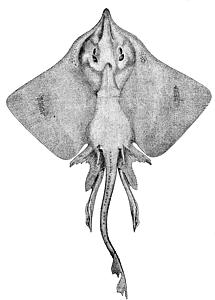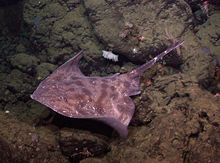Skate
| Skates | ||||||||||||||
|---|---|---|---|---|---|---|---|---|---|---|---|---|---|---|
 Barndoor Skate, Dipturus laevis
| ||||||||||||||
| Scientific classification | ||||||||||||||
|
In zoology, skate is the common name for cartilaginous fish belonging to the family Rajidae in the order Rajiformes (or Batoidea) of rays, characterized by enlarged and flat pectoral fins continuous with the head, no anal fin, two dorsal fins, and a very slender, spineless tail.
Ecologically, skates are important in food chains, consuming smaller fish and crustaceans, as well as mollusks, and being consumed by sharks, among other predators. There is concern that overfishing of sharks in some areas has led to a disruption of this delicate balance, with a resultant increase in some skate and ray populations endangering the scallop populations (Schmid 2007). For humans, skates with their unique form and undulating movements add to the wonder of nature and the large pectoral fins of skates are edible and are eaten by people. Some skate species, such as the common skate and white skate, are considered to be critically endangered.
Overview and description
The Chondrichthyes or "cartilaginous fishes" are jawed fish with paired fins, paired nostrils, scales, two-chambered hearts, and skeletons made of cartilage rather than bone. They are divided into two subclasses: Elasmobranchii (sharks, rays, and skates) and Holocephali (chimaera, sometimes called ghost sharks). The Elasmobranchii are sometimes divided into two superorders, Selachimorpha (sharks) and Batoidea or Batidoidimorpha (rays, skates, sawfish). Nelson (1994) notes that there is growing acceptance of the view that sharks and rays together form a monophyletic group (superorder Euselachii), and sharks without rays are a paraphyletic group.
Rays, including skates, are placed in the order Rajiformes of the superorder Batoidea (or superorder Euselachii with the sharks). Members of Rajiformes are characterized by ventral gill openings, and the anterior edge of the pectoral fin, which is greatly enlarged, is attached to the side of the head anterior to the gill openings (Nelson 1994). Members of Rajiformes also lack an anal fin and the eyes and spiracles are on the dorsal surface (Nelson 1994). The body is normally strongly depressed and in most water for breathing is taken in through the spiracle rather than the mouth.
Description of skates
The skates are all placed in the family Rajidae within the order Rajiformes. The skates are characterized by an extremely slender tail with lateral folds, weak electric organs derived from caudal muscles, from zero to two dorsal fins, and the caudal fin is either absent, reduced, or moderately well-developed (Nelson 1994). Most skates have prickles on the skin, and often with a row along the midline of the back (Nelson 1994). They are characterized as well by eggs that are encased in a horny capsule with four long tips (Nelson 1994).
There are more than 200 described species in from 18 to 26 genera, according to the taxonomic scheme. Nelson (1994) recognizes 18 genera. Murch (2007) list 26 genera.
Skates are benthic (bottom-dwelling) and are found throughout the world, in all oceans from Arctic to Antarctic waters, from continental shelves down to the abyssal zone. They are carnivorous, feeding mostly on smaller fish and crustaceans.
Skates are oviparous fishes, laying eggs in a horny case known as a mermaid's purse. It is thought that egg-laying in skates is an evolutionary reversal, that is, skates are descended from ovoviviparous ancestors (Froese and Pauly 2004). Ovoviviparous animals develop within eggs that remain within the mother's body up until they hatch or are about to hatch.
Conservation and uses
The common skate, Dipturus batis, is the largest found in British waters. It has a long, pointed snout. However, the most common skate in British seas is the thornback ray, Raja clavata. They are frequently caught by trawling. Common skate and white skate are assessed as Critically Endangered by IUCN (World Conservation Union).
Skate winglike pectoral fins are consumed by people, and Herbst (2001) lists that "their delicious flesh is firm, white and sweet—not unlike that of scallop. Herbst notes that they can be prepared by poaching, baking, and frying. However, the Marine Conservation Society (2007) lists skates as "fish to avoid" eating—unless certain that one is consuming a species with a stable population—because in general skates are highly vulnerable to exploitation given their slow growth, high age at maturity, and low reproductive rates. Of particular concern in this regard is the larger skate species, and in particular the long nosed skates like the common skate.
Genera
- Amblyraja
- Arhynchobatis
- Atlantoraja
- Bathyraja
- Breviraja
- Cruriraja
- Dactylobatus
- Dipturus
- Fenestraja
- Gurgesiella
- Irolita
- Leucoraja
- Malacoraja
- Neoraja
- Notoraja
- Okamejei
- Pavoraja
- Psammobatis
- Pseudoraja
- Raja
- Rajella
- Rhinoraja
- Rioraja
- Rostroraja
- Sympterygia
- Zearaja
ReferencesISBN links support NWE through referral fees
- Froese, R. and D. Pauly. (Eds.). 2004. Family Rajidae: Skates. FishBase'. Retrieved December 14, 2007.
- Herbst, S. T. 2001. The New Food Lover's Companion: Comprehensive Definitions of Nearly 6,000 Food, Drink, and Culinary Terms. Barron's Cooking Guide. Hauppauge, NY: Barron's Educational Series. ISBN 0764112589.
- Marine Conservation Society. 2007. Fish to avoid: Skates and rays. Marine Conservation Society. Retrieved December 14, 2007.
- Murch, A. 2007. Shark taxonomy. Elasmodiver. Retrieved December 14, 2007.
- Nelson, J. S. 1994. Fishes of the World. New York: John Wiley and Sons. ISBN 0471547131.
- Schmid, R. E. 2007. Shark deaths upset rest of food chain: Shark overfishing may be endangering scallop populations, say scientists. Associated Press/ABCNews May 29, 2007.
Credits
New World Encyclopedia writers and editors rewrote and completed the Wikipedia article in accordance with New World Encyclopedia standards. This article abides by terms of the Creative Commons CC-by-sa 3.0 License (CC-by-sa), which may be used and disseminated with proper attribution. Credit is due under the terms of this license that can reference both the New World Encyclopedia contributors and the selfless volunteer contributors of the Wikimedia Foundation. To cite this article click here for a list of acceptable citing formats.The history of earlier contributions by wikipedians is accessible to researchers here:
The history of this article since it was imported to New World Encyclopedia:
Note: Some restrictions may apply to use of individual images which are separately licensed.
